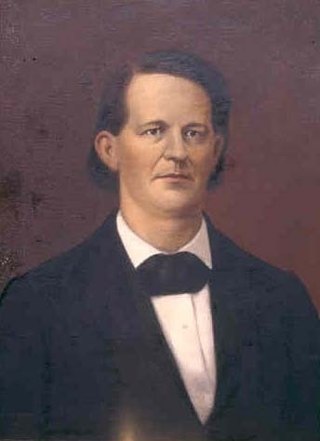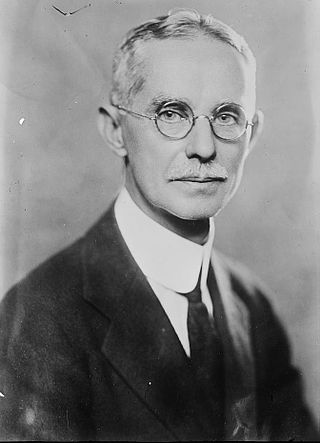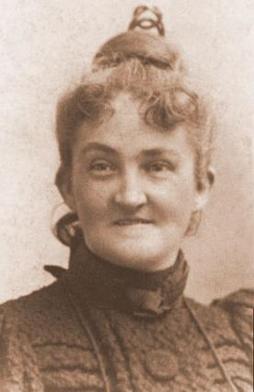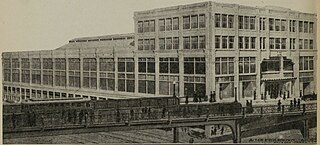
Athens is a consolidated city-county in the U.S. state of Georgia. Downtown Athens lies about 70 miles (110 km) northeast of downtown Atlanta. The University of Georgia, the state's flagship public university and an R1 research institution, is in Athens and contributed to its initial growth. In 1991, after a vote the preceding year, the original City of Athens abandoned its charter to form a unified government with Clarke County, referred to jointly as Athens–Clarke County where it is the county seat.

Rebecca Ann Felton was an American writer, politician, white supremacist, and slave owner who was the first woman to serve in the United States Senate, serving for only one day. She was a prominent member of the Georgia upper class who advocated for prison reform, women's suffrage and education reform. Her husband, William Harrell Felton, served in both the United States House of Representatives and the Georgia House of Representatives, and she helped organize his political campaigns. Historian Numan Bartley wrote that by 1915 Felton "was championing a lengthy feminist program that ranged from prohibition to equal pay for equal work yet never accomplished any feat because she held her role because of her husband."

Howell Cobb was an American and later Confederate political figure. A southern Democrat, Cobb was a five-term member of the United States House of Representatives and the speaker of the House from 1849 to 1851. He also served as the 40th governor of Georgia (1851–1853) and as a secretary of the treasury under President James Buchanan (1857–1860).

Thomas Reade Rootes Cobb, also known as T. R. R. Cobb, was an American lawyer, author, politician, and Confederate States Army officer, killed in the Battle of Fredericksburg during the American Civil War. He was the brother of noted Confederate statesman Howell Cobb.

Charles Holmes Herty Sr. was an American academic, scientist, and entrepreneur. Serving in academia as a chemistry professor to begin his career, Herty concurrently promoted collegiate athletics including creating the first varsity football team at the University of Georgia. His academic research gravitated towards applied chemistry where he revolutionized the turpentine industry in the United States. While serving as the president of the American Chemical Society, Herty became a national advocate for the nascent American chemical industry and left academia to preside over the Synthetic Organic Chemical Manufacturers' Association (SOCMA) and the Chemical Foundation. He was also instrumental in the creation of the National Institutes of Health. Towards the end of his career, Herty's research and advocacy led to the creation of a new pulp industry in the Southern United States that utilized southern pine trees to create newsprint.

Seney–Stovall Chapel is a church building in Athens, Georgia, United States. Part of Cobbham Historic District, it is located in the grounds of the former Lucy Cobb Institute, itself now part of the University of Georgia. It is named for George I. Seney and Nellie Stovall.

Mildred Lewis Rutherford was a prominent white supremacist speaker, educator, and author from Athens, Georgia. She served the Lucy Cobb Institute, as its head and in other capacities, for over forty years, and oversaw the addition of the Seney-Stovall Chapel to the school. Heavily involved in many organizations, she became the historian general of the United Daughters of the Confederacy (UDC), and a speech given for the UDC was the first by a woman to be recorded in the Congressional Record. She was a prolific writer in historical subjects and an advocate of the Lost Cause narrative. Rutherford was distinctive in dressing as a southern belle for her speeches. She held strong pro-Confederacy, proslavery views and opposed women's suffrage.

The Franklin House is a three-story brick historic building located at 464-480 East Broad Street, in Athens, Georgia. It was built in three phases between 1845 and 1860. Originally a mercantile building with an antebellum hotel on the upper floors, from 1865 to 1972 it was a hardware store. In the 1970s it was listed on the National Register of Historic Places, and in the 1980s it was restored and turned into office space and apartments.

Mildred Seydell was an American pioneering journalist in Georgia. Seydel wrote as a syndicated columnist and founded the Seydell Journal, a quarterly journal that was the successor to The Think Tank a short-lived biweekly journal of poetry, articles and reviews (1940–1947). She also founded the Mildred Seydell Publishing Company, and was a regular on the lecture circuit.
The Georgia Women of Achievement (GWA) recognizes women natives or residents of the U.S. state of Georgia for their significant achievements or statewide contributions. The concept was first proposed by Rosalynn Carter in 1988. The first induction was in 1992 at Wesleyan College, and has continued annually. The induction ceremonies are held each year during March, designated as Women's History Month. The organization consists of a Board of Trustees and a Board of Selections. Nominees must have been dead no less than ten years. Georgians, or those associated with Georgia, are selected based on the individual's impact on society. Nominations are proposed through documentation and an online nomination form, and must be submitted prior to October of any given year. GWA has traveling exhibits and speakers available upon request.

The Peachtree Arcade was a shopping arcade in downtown Atlanta, Georgia, United States. The building, modeled after the Arcade in Cleveland, was designed by Atlanta-based architect A. Ten Eyck Brown and was located between Peachtree Street and Broad Street near Five Points. Construction began in 1917 and was completed the following year. Located in the city's central business district, it was very popular with citizens, functioning as an unofficial "civic center" for the city. However, by the 1960s, the arcade was facing increased competition from shopping malls located in Atlanta's suburbs, and in 1964, the building was demolished to make way for the First National Bank Building, a skyscraper that, at the time of its construction, was the tallest building in both Atlanta and the southeastern United States. In 1993, the American Institute of Architects named the building as one of Atlanta's most notable landmarks to have been destroyed.
Mary Ann Rutherford Lipscomb (1848–1918) was an educator born in Athens, Georgia. Lipscomb believed in childhood education, and she helped make primary education required for all children in Georgia.
Julia Flisch was a writer, educator, and advocate for women's rights to education and independence from Georgia. Flisch was known for her call to "Give the girls a chance!" in her fight for equity in education access.

William Winstead Thomas (1848–1904) was an American insurance company president and an architect.
George Ingraham Seney was a New York City banker, art collector, and benefactor. He was the father of symphonic music executive Mary Seney Sheldon.

Rosa Louise Woodberry was an American journalist, educator, and stenographer. She was the founder and principal of Woodberry Hall, and the first woman to attend the University of Georgia.

Josephine Mathewson Wilkins was an American social activist, president of the Georgia State League of Women Voters. She is a 2022 inductee into the Georgia Women of Achievement.
Blandina Dillard Russell(Ina) (February 18, 1868 – August 30, 1953) was an American teacher and homemaker who acted as the First Lady of the state of Georgia during the tenure of her son Richard Russell Jr.
The University of Georgia desegregation riot was an incident of mob violence by proponents of racial segregation on January 11, 1961. The riot was caused by segregationists' protest over the desegregation of the University of Georgia (UGA) in Athens, Georgia following the enrollment of Hamilton E. Holmes and Charlayne Hunter, two African American students. The two had been admitted to the school several days earlier following a lengthy application process that led to a court order mandating that the university accept them. On January 11, several days after the two had registered, a group of approximately 1,000 people conducted a riot outside of Hunter's dormitory. In the aftermath, Holmes and Hunter were suspended by the university's dean, though this suspension was later overturned by a court order. Several rioters were arrested, with several students placed on disciplinary probation, but no one was charged with inciting the riot. In an investigation conducted by the Federal Bureau of Investigation, it was revealed that some of the riot organizers were in contact with elected state officials who approved of the riot and assured them of immunity for conducting the riot.
Georgia Baptist College was a private grade school and college in Macon, Georgia, United States. It was founded in 1899 as Central City College and was renamed in 1938. It closed due to financial difficulties in 1956.
















